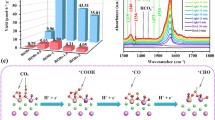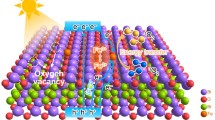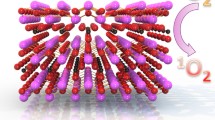Abstract
The light absorption properties of semiconductor-based photocatalysts to a large extent determine the relevant catalytic performance. Traditional strategies in broadening the light absorption range are usually accompanied with unfavorable changes in redox ability and dynamics of photoinduced species that would confuse the comprehensive optimization. In this work, we propose a nontrivial excitonic transition regulation strategy for gaining sub-bandgap light absorption in low-dimensional semiconductor-based photocatalysts. Using bismuth oxybromide (BiOBr) as a model system, we highlight that the light absorption cut-off edge could be effectively extended up to 500 nm by introducing Bi vacancies. On the basis of theoretical simulations and spectroscopic analyses, we attributed the broadening of light absorption to the promotion of excitonic transition that is generally forbidden in pristine BiOBr system, associated with Bi-vacancy-induced excited-state symmetry breaking. In addition, Bi vacancy was demonstrated to implement negligible effects on other photoexcitation properties like excited-state energy-level profiles and kinetics. Benefiting from these features, the defective sample exhibits a notable advantage in gaining visible-light-driven photocatalytic reactions.

Similar content being viewed by others
References
Zhao, Z. Research progress of semiconductor photocatalysis applied to environmental governance. IOP Conf. Seri. Earth Environ. Sci. 2021, 631, 012022.
Hoffmann, M. R.; Martin, S. T.; Choi, W.; Bahnemann, D. W. Environmental applications of semiconductor photocatalysis. Chem. Rev. 1995, 95, 69–96.
Mills, A.; Le Hunte, S. An overview of semiconductor photocatalysis. J. Photochem. Photobiol. A Chem. 1997, 108, 1–35.
Serpone, N.; Emeline, A. V. Semiconductor photocatalysis—Past, present, and future outlook. J. Phys. Chem. Lett. 2012, 3, 673–677.
Banerjee, T.; Podjaski, F.; Kröger, J.; Biswal, B. P.; Lotsch, B. V. Polymer photocatalysts for solar-to-chemical energy conversion. Nat. Rev. Mater. 2021, 6, 168–190.
Wang, F. F.; Li, Q.; Xu, D. S. Recent progress in semiconductor-based nanocomposite photocatalysts for solar-to-chemical energy conversion. Adv. Energy Mater. 2017, 7, 1700529.
Liu, Y. Q.; Cheng, P.; Li, T. F.; Wang, R.; Li, Y. W.; Chang, S. Y.; Zhu, Y.; Cheng, H. W.; Wei, K. H.; Zhan, X. W. et al. Unraveling sunlight by transparent organic semiconductors toward photovoltaic and photosynthesis. ACS Nano 2019, 13, 1071–1077.
Hu, W. Y.; Li, Q. Y.; Xu, D.; Zhai, G. Y.; Zhang, S. N.; Li, D.; He, X. X.; Jia, J. P.; Chen, J. S.; Li, X. H. Rapidly and mildly transferring anatase phase of graphene-activated TiO2 to rutile with elevated Schottky barrier: Facilitating interfacial hot electron injection for vis-NIR driven photocatalysis. Nano Res. 2022, 15, 10142–10147.
Hu, W. Y.; Li, Q. Y.; Zhai, G. Y.; Lin, Y. X.; Li, D.; He, X. X.; Lin, X.; Xu, D.; Sun, L. H.; Zhang, S. N. et al. Facilitating hot electron injection from graphene to semiconductor by rectifying contact for vis–NIR-driven H2O2 production. Small. 2022, 18, 2200885.
Zhang, L. W.; Man, Y.; Zhu, Y. F. Effects of Mo replacement on the structure and visible-light-induced photocatalytic performances of Bi2WO6 photocatalyst. ACS Catal. 2011, 1, 841–848.
Sun, X. S.; Luo, X.; Zhang, X. D.; Xie, J. F.; Jin, S.; Wang, H.; Zheng, X. S.; Wu, X. J.; Xie, Y. Enhanced superoxide generation on defective surfaces for selective photooxidation. J. Am. Chem. Soc. 2019, 141, 3797–3801.
Garfield, D. J.; Borys, N. J.; Hamed, S. M.; Torquato, N. A.; Tajon, C. A.; Tian, B. N.; Shevitski, B.; Barnard, E. S.; Suh, Y. D.; Aloni, S. et al. Enrichment of molecular antenna triplets amplifies upconverting nanoparticle emission. Nat. Photon. 2018, 12, 402–407.
Sun, D. F.; Huang, L.; Li, L.; Yu, Y.; Du, G. H.; Xu, B. S. Plasma enhanced Bi/Bi2O2CO3 heterojunction photocatalyst via a novel in-situ method. J. Colloid Interface Sci. 2020, 571, 80–89.
Jiang, J.; Ling, C. Y.; Xu, T.; Wang, W. H.; Niu, X. H.; Zafar, A.; Yan, Z. Z.; Wang, X. M.; You, Y. M.; Sun, L. T. et al. Defect engineering for modulating the trap states in 2D photoconductors. Adv. Mater. 2018, 30, 1804332.
Xiang, Q. J.; Yu, J. G.; Jaroniec, M. Graphene-based semiconductor photocatalysts. Chem. Soc. Rev. 2012, 41, 782–796.
Voiry, D.; Shin, H. S.; Loh, K. P.; Chhowalla, M. Low-dimensional catalysts for hydrogen evolution and CO2 reduction. Nat. Rev. Chem. 2018, 2, 0105.
Zhang, K. X.; Su, H.; Wang, H. H.; Zhang, J. J.; Zhao, S. Y.; Lei, W. W.; Wei, X.; Li, X. H.; Chen, J. S. Atomic-scale Mott–Schottky heterojunctions of boron nitride monolayer and graphene as metalfree photocatalysts for artificial photosynthesis. Adv. Sci. 2018, 5, 1800062.
Mongin, C.; Garakyaraghi, S.; Razgoniaeva, N.; Zamkov, M.; Castellano, F. N. Direct observation of triplet energy transfer from semiconductor nanocrystals. Science. 2016, 351, 369–372.
Ugeda, M. M.; Bradley, A. J.; Shi, S. F.; Da Jornada, F. H.; Zhang, Y.; Qiu, D. Y.; Ruan, W.; Mo, S. K.; Hussain, Z.; Shen, Z. X. et al. Giant bandgap renormalization and excitonic effects in a monolayer transition metal dichalcogenide semiconductor. Nat. Mater. 2014, 13, 1091–1095.
Luo, X.; Liang, G. J.; Han, Y. Y.; Li, Y. L.; Ding, T.; He, S.; Liu, X.; Wu, K. F. Triplet energy transfer from perovskite nanocrystals mediated by electron transfer. J. Am. Chem. Soc. 2020, 142, 11270–11278.
Chen, X. B.; Shen, S. H.; Guo, L. J.; Mao, S. S. Semiconductor-based photocatalytic hydrogen generation. Chem. Rev. 2010, 110, 6503–6570.
Chen, C. C.; Ma, W. H.; Zhao, J. C. Semiconductor-mediated photodegradation of pollutants under visible-light irradiation. Chem. Soc. Rev. 2010, 39, 4206–4219.
Sun, H. L.; Wei, K.; Wu, D.; Jiang, Z. F.; Zhao, H.; Wang, T. Q.; Zhang, Q.; Wong, P. K. Structure defects promoted exciton dissociation and carrier separation for enhancing photocatalytic hydrogen evolution. Appl. Catal. B Environ. 2020, 264, 118480.
Tran, V.; Soklaski, R.; Liang, Y. F.; Yang, L. Layer-controlled band gap and anisotropic excitons in few-layer black phosphorus. Phys. Rev. B 2014, 89, 235319.
Wang, H.; Chen, S. C.; Yong, D. Y.; Zhang, X. D.; Li, S.; Shao, W.; Sun, X. S.; Pan, B. C.; Xie, Y. Giant electron–hole interactions in confined layered structures for molecular oxygen activation. J. Am. Chem. Soc. 2017, 139, 4737–4742.
Wang, H.; Yong, D. Y.; Chen, S. C.; Jiang, S. L.; Zhang, X. D.; Shao, W.; Zhang, Q.; Yan, W. S.; Pan, B. C.; Xie, Y. Oxygen-vacancy-mediated exciton dissociation in BiOBr for boosting charge-carrier-involved molecular oxygen activation. J. Am. Chem. Soc. 2011, 140, 1760–1766.
Kresse, G.; Furthmüller, J. Efficient iterative schemes for ab initio total-energy calculations using a plane-wave basis set. Phys. Rev. B 1996, 54, 11169–11186.
Kresse, G.; Furthmüller, J. Efficiency of ab-initio total energy calculations for metals and semiconductors using a plane-wave basis set. Comput. Mater. Sci. 1996, 6, 15–50.
Kresse, G.; Furthmüller, J.; Hafner, J. Theory of the crystal structures of selenium and tellurium: The effect of generalized-gradient corrections to the local-density approximation. Phys. Rev. B 1994, 50, 13181–13185.
Kresse, G.; Joubert, D. From ultrasoft pseudopotentials to the projector augmented-wave method. Phys. Rev. B 1999, 59, 1758–1775.
Perdew, J. P.; Burke, K.; Ernzerhof, M. Generalized gradient approximation made simple. Phys. Rev. Lett. 1996, 77, 3865–3868.
Wang, D. J.; Shen, H. D.; Guo, L.; Wang, C.; Fu, F. Porous BiOBr/Bi2MoO6 heterostructures for highly selective adsorption of methylene blue. ACS Omega 2016, 1, 566–577.
Qu, D. S.; Liu, X. C.; Huang, M.; Lee, C.; Ahmed, F.; Kim, H.; Ruoff, R. S.; Hone, J.; Yoo, W. J. Carrier-type modulation and mobility improvement of thin MoTe2. Adv. Mater. 2017, 29, 1606433.
Park, C. S.; Lee, C. J.; Kim, E. K. Stable p-type properties of single walled carbon nanotubes by electrochemical doping. Phys. Chem. Chem. Phys. 2015, 17, 16243–16245.
Petravic, M.; Gao, Q.; Llewellyn, D.; Deenapanray, P. N. K.; Macdonald, D.; Crotti, C. Broadening of vibrational levels in X-ray absorption spectroscopy of molecular nitrogen in compound semiconductors. Chem. Phys. Lett. 2006, 425, 262–266.
Su, Y. Q.; Zhu, Y.; Yong, D. Y.; Chen, M. M.; Su, L. X.; Chen, A. Q.; Wu, Y. Y.; Pan, B. C.; Tang, Z. K. Enhanced exciton binding energy of ZnO by long-distance perturbation of doped Be atoms. J. Phys. Chem. Lett. 2016, 7, 1484–1489.
Sun, J. J.; Li, X. Y.; Zhao, Q. D.; Liu, B. J. Ultrathin nanoflake-assembled hierarchical BiOBr microflower with highly exposed {001} facets for efficient photocatalytic degradation of gaseous ortho-dichlorobenzene. Appl. Catal. B Environ. 2021, 281, 119478.
Jiao, X. C.; Chen, Z. W.; Li, X. D.; Sun, Y. F.; Gao, S.; Yan, W. S.; Wang, C. M.; Zhang, Q.; Lin, Y.; Luo, Y. et al. Defect-mediated electron-hole separation in one-unit-cell ZnIn2S4 layers for boosted solar-driven CO2 reduction. J. Am. Chem. Soc. 2017, 139, 7586–7594.
Mongin, C.; Moroz, P.; Zamkov, M.; Castellano, F. N. Thermally activated delayed photoluminescence from pyrenyl-functionalized CdSe quantum dots. Nat. Chem. 2018, 10, 225–230.
Acknowledgements
This work was supported by the National Key Research and Development Program of China (Nos. 2022YFA1502903 and 2021YFA1501502), the Strategic Priority Research Program of Chinese Academy of Sciences (Nos. XDB36000000 and XDB0450102), the National Natural Science Foundation of China (Nos. 92163105, T2122004, 21890754, U2032212, U2032160, and 22275179), the Anhui Provincial Key Research and Development Program (No. 2022a05020054), the Youth Innovation Promotion Association of CAS (No. Y2021123), and the Fundamental Research Funds for the Central Universities (No. WK2060000039). A portion of this work was performed on the Steady High Magnetic Field Facilities, High Magnetic Field Laboratory, CAS. The numerical calculations in this paper have been done on the supercomputing system in the Supercomputing Center of University of Science and Technology of China. The authors thank MCD-B (Soochow Beamline for Energy Materials) at NSRL for the synchrotron beamtime.
Author information
Authors and Affiliations
Corresponding authors
Electronic Supplementary Material
12274_2023_5941_MOESM1_ESM.pdf
Vacancy-engineering-mediated activation of excitonic transition for boosting visible-light-driven photocatalytic oxidative coupling of amines
Rights and permissions
About this article
Cite this article
Liu, W., Li, L., Zhang, P. et al. Vacancy-engineering-mediated activation of excitonic transition for boosting visible-light-driven photocatalytic oxidative coupling of amines. Nano Res. 16, 12655–12661 (2023). https://doi.org/10.1007/s12274-023-5941-2
Received:
Revised:
Accepted:
Published:
Issue Date:
DOI: https://doi.org/10.1007/s12274-023-5941-2




